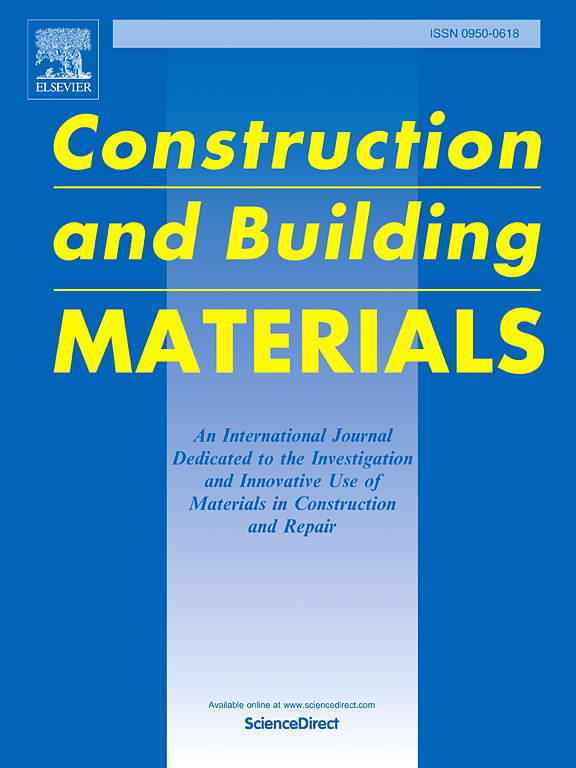Research on skid resistance and prediction model of hot in-place recycled asphalt pavement based on gradation and aggregate characteristics
IF 7.4
1区 工程技术
Q1 CONSTRUCTION & BUILDING TECHNOLOGY
引用次数: 0
Abstract
Hot in-place recycling (HIR) has emerged as a sustainable maintenance technology that provides advantages in resource conservation and emission reduction. However, long-term monitoring of road maintenance reveals that the rate of skid resistance decay in HIR pavements is significantly higher than that observed in newly constructed asphalt pavements. This research systematically investigates the effects of five gradations and five types of coarse aggregates on the skid resistance of hot in-place recycled asphalt mixtures (HIRM) using an indoor accelerated polishing device (IAPD). Key parameters, including Mean Texture Depth (MTD) and British Pendulum Number (BPN), were measured. Additionally, the surface morphology, mineral composition, and elemental distribution of the coarse aggregates were analyzed using microscopic testing methods. Finally, predictive models for MTD and BPN were developed through multiple linear regression, and the accuracy of these models was validated via indoor experiments. Results indicate that variations in gradation, particularly the passing rate of the 4.75 mm sieve (P4.75), significantly influence MTD, while the properties of coarse aggregates have a more pronounced effect on BPN. Pearson correlation analysis reveals a strong negative correlation between P4.75 and both the initial and final MTD values, with correlation coefficients of −0.96 and −0.94, respectively. Additionally, the final polished stone value (PSVfinal) of coarse aggregates and the overall average hardness (HIRMh) exhibit correlation coefficients with BPN of 0.87 and 0.79, respectively. Following the correlation analysis, several indicators were selected for a multivariable regression analysis, which successfully established a decay model for the MTD index (R² > 0.98) and a logarithmic decay model for BPN (R² > 0.96). Validation tests confirmed that the prediction errors for the models were below 7 % and 4 %, respectively. This research provides theoretical insights for material design and the prediction of skid resistance of HIR asphalt pavements.
基于级配和集料特性的热原位再生沥青路面抗滑性及预测模型研究
就地热回收(HIR)作为一种具有节约资源和减少排放优势的可持续维护技术已经崭露头角。然而,对道路养护的长期监测表明,HIR路面的防滑衰减率明显高于新建沥青路面。本研究使用室内加速抛光装置(IAPD)系统地研究了五种级配和五种粗集料对就地热再生沥青混合料(HIRM)的抗滑性的影响。测量了平均纹理深度(MTD)和英国钟摆数(BPN)等关键参数。此外,采用显微测试方法对粗集料的表面形貌、矿物组成和元素分布进行了分析。最后,通过多元线性回归建立了MTD和BPN的预测模型,并通过室内实验验证了模型的准确性。结果表明,级配的变化,特别是4.75 mm筛的通过率(P4.75),显著影响MTD,而粗集料的性质对BPN的影响更为显著。Pearson相关分析显示,P4.75与MTD初始值和最终值均呈较强的负相关,相关系数分别为- 0.96和- 0.94。粗集料的最终抛光石值(PSVfinal)和总体平均硬度(HIRMh)与BPN的相关系数分别为0.87和0.79。在进行相关分析后,选取多个指标进行多变量回归分析,成功建立了MTD指数(R²>;0.98)和BPN的对数衰减模型(R²>;0.96)。验证试验证实,模型的预测误差分别小于7 %和4 %。本研究为HIR沥青路面的材料设计和抗滑性预测提供了理论依据。
本文章由计算机程序翻译,如有差异,请以英文原文为准。
求助全文
约1分钟内获得全文
求助全文
来源期刊

Construction and Building Materials
工程技术-材料科学:综合
CiteScore
13.80
自引率
21.60%
发文量
3632
审稿时长
82 days
期刊介绍:
Construction and Building Materials offers an international platform for sharing innovative and original research and development in the realm of construction and building materials, along with their practical applications in new projects and repair practices. The journal publishes a diverse array of pioneering research and application papers, detailing laboratory investigations and, to a limited extent, numerical analyses or reports on full-scale projects. Multi-part papers are discouraged.
Additionally, Construction and Building Materials features comprehensive case studies and insightful review articles that contribute to new insights in the field. Our focus is on papers related to construction materials, excluding those on structural engineering, geotechnics, and unbound highway layers. Covered materials and technologies encompass cement, concrete reinforcement, bricks and mortars, additives, corrosion technology, ceramics, timber, steel, polymers, glass fibers, recycled materials, bamboo, rammed earth, non-conventional building materials, bituminous materials, and applications in railway materials.
 求助内容:
求助内容: 应助结果提醒方式:
应助结果提醒方式:


